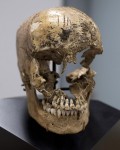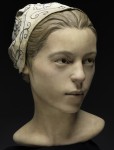 A team of archaeologists from the Jamestown Rediscovery Project have unearthed hard evidence that the colonists ate their own dead during the deadly winter of 1609-1610 known as the Starving Time. On July 27th, 2012, an excavation of a kitchen cellar in one of the oldest buildings in James Fort uncovered what appeared to be human teeth. That wasn’t an immediate smoking gun. A great many artifacts and remains both human and animal have been discovered jumbled together in cellars from the general cleanup ordered by the new governor in the summer of 1610.
A team of archaeologists from the Jamestown Rediscovery Project have unearthed hard evidence that the colonists ate their own dead during the deadly winter of 1609-1610 known as the Starving Time. On July 27th, 2012, an excavation of a kitchen cellar in one of the oldest buildings in James Fort uncovered what appeared to be human teeth. That wasn’t an immediate smoking gun. A great many artifacts and remains both human and animal have been discovered jumbled together in cellars from the general cleanup ordered by the new governor in the summer of 1610.
 Further excavation revealed half a skull, skull fragments and a piece of the right tibia in a layer of butchered horse and dog bones dating to the Starving Time. There were signs of violence — the skull was cut open — but determining the nature and source of the violence would require laboratory analysis. The human remains were dug out of the cellar in a solid block of earth and taken to the lab to be minutely excavated in a controlled environment where even the smallest fragments would not be lost or damaged.
Further excavation revealed half a skull, skull fragments and a piece of the right tibia in a layer of butchered horse and dog bones dating to the Starving Time. There were signs of violence — the skull was cut open — but determining the nature and source of the violence would require laboratory analysis. The human remains were dug out of the cellar in a solid block of earth and taken to the lab to be minutely excavated in a controlled environment where even the smallest fragments would not be lost or damaged.
 Once the bones were cleaned and stable, chief archaeologist William Kelso called in a frequent collaborator, Dr. Douglas Owsley, head of physical anthropology at the Smithsonian’s National Museum of Natural History, to analyze them. They found unerupted third molars with incomplete roots and a growth plate at the knee that was in the early stages of fusion. Both of these suggest the bones belonged to someone who was 14 years old at time of death. The shape of the cranium indicates she was female. Stable carbon and nitrogen isotope analysis identified her background: she was English, raised on a wheat-based diet of some quality, so either she was a daughter or sister of a well-off colonist, or a servant who ate well in her masters’ kitchen.
Once the bones were cleaned and stable, chief archaeologist William Kelso called in a frequent collaborator, Dr. Douglas Owsley, head of physical anthropology at the Smithsonian’s National Museum of Natural History, to analyze them. They found unerupted third molars with incomplete roots and a growth plate at the knee that was in the early stages of fusion. Both of these suggest the bones belonged to someone who was 14 years old at time of death. The shape of the cranium indicates she was female. Stable carbon and nitrogen isotope analysis identified her background: she was English, raised on a wheat-based diet of some quality, so either she was a daughter or sister of a well-off colonist, or a servant who ate well in her masters’ kitchen.
The cause of death could not be determined, but the treatment the body received after death was writ on the bones.
Owsley and his research team identified a number of features on the skull and tibia that indicated the individual was cannibalized. Four shallow chops to the forehead represent a failed first attempt to open the skull. The back of the head was then struck by a series of deep, forceful chops from a small hatchet or cleaver. The final blow split the cranium open. Sharp cuts and punctures mark the sides and bottom of the mandible, reflecting efforts to remove tissue from the face and throat using a knife.
“The desperation and overwhelming circumstances faced by the James Fort colonists during the winter of 1609–1610 are reflected in the postmortem treatment of this girl’s body,” said Owsley. “The recovered bone fragments have unusually patterned cuts and chops that reflect tentativeness, trial and complete lack of experience in butchering animal remains. Nevertheless, the clear intent was to dismember the body, removing the brain and flesh from the face for consumption.”
The tibia also appears to have been used for nourishment. It was chopped below the knee. The blow broke the bone and exposed the marrow. Fine cuts at the top of the bone are testament to the sharp knife that was used to dismember the leg.
 The Jamestown Rediscovery team named her Jane to underscore that she was not just an artifact or research topic, but a person who lived and died way too young in horrible circumstances. A facial reconstruction created from a CT scan and a virtual model that filled in the missing parts of the skull further personalized her. The reconstruction, the skeletal remains and artifacts from the Starving Time are now on display in the Nathalie P. and Alan M. Voorhees Archaearium at Historic Jamestowne on Jamestown Island.
The Jamestown Rediscovery team named her Jane to underscore that she was not just an artifact or research topic, but a person who lived and died way too young in horrible circumstances. A facial reconstruction created from a CT scan and a virtual model that filled in the missing parts of the skull further personalized her. The reconstruction, the skeletal remains and artifacts from the Starving Time are now on display in the Nathalie P. and Alan M. Voorhees Archaearium at Historic Jamestowne on Jamestown Island.
Jamestown was the first permanent English colony in North America. The Virginia Company got a charter to settle land on Chesapeake Bay from King James I in 1606. In 1607, the first settlers under Captain John Smith reached Jamestown Island. There were immediate supply problems exacerbated by conflict with the local Algonquian tribes. There were more second and third sons of nobility than are strictly useful when subsistence farming is needed, and Smith, the first president of the settlement, tried to encourage more hands-on labor by instituting no-work-no-food policies. Smith also struck deals with the Powhatan Indians to secure food supplies in the winter.
 In the winter of 1609, however, Captain Smith was back in England. He had been injured in a mysterious explosion, and political in-fighting with colony leaders resulted in his being replaced as president by George Percy, the youngest son of Henry Percy, 8th Earl of Northumberland. Percy was chronically ill (epilepsy and asthma), not a keen politician or diplomat. When a new supply fleet arrived from England in the summer of 1609, the supplies had been lost at sea and the 300 new settlers — Jane among them — ate the town’s seven acres of maize in three days. The Powhatans, themselves suffering from the same long drought crippling Jamestown farming, were in no mood to prop up the English again. They were more in the mood to fight them, in fact.
In the winter of 1609, however, Captain Smith was back in England. He had been injured in a mysterious explosion, and political in-fighting with colony leaders resulted in his being replaced as president by George Percy, the youngest son of Henry Percy, 8th Earl of Northumberland. Percy was chronically ill (epilepsy and asthma), not a keen politician or diplomat. When a new supply fleet arrived from England in the summer of 1609, the supplies had been lost at sea and the 300 new settlers — Jane among them — ate the town’s seven acres of maize in three days. The Powhatans, themselves suffering from the same long drought crippling Jamestown farming, were in no mood to prop up the English again. They were more in the mood to fight them, in fact.
Constantly in danger of being picked off should they leave the safety of the town, the settlers stayed cooped up inside the palisades for months. That’s never good news for an already weak and salty water supply. The setting was ripe for famine.
Thirteen years after his return to England in 1612, Percy would try to defend his administration, such as it was, in a letter to his nephew Algernon Lord Percy, 10th Earl of Northumberland (pdf). It’s all about deflecting blame, starting with an elencation of all the other American colonies that wound up eating shoe leather and each other.
The Spanyards plantacyon in the River of Plate and the streightes of Magelane Suffered also in so mutche thatt haveinge eaten upp all their horses to susteine themselves w[i]thal, Mutenies did aryse and growe amongste them, for the w[hi]ch the generall Diego Mendosa cawsed some of them to be executed, Extremety of hunger inforceinge others secrettly in the night to Cutt downe Their deade fellowes from of the gallowes and to bury them in their hungry Bowelles.
Gross but deft turn of phrase, I’ll give him that.
The Diego Mendoza he’s talking about was the brother of Don Pedro de Mendoza, founder of Buenos Aires. In 1534, Don Pedro was given a grant by King Charles V to colonize/conquer a wide swath of South America from the panhandle of Brazil to the mouth of the Rio de la Plata. He lost most of his ships in a storm on the way over, and once he got there, he and his men were entirely dependent on the indigenous Querandíes people for food, and it’s not like they were rolling in it. When the tribes got sick of supporting the Spaniards, they began to starve. Sound familiar? Don Pedro sent his brother with 300 infantry and 30 cavalry to get what they wanted by force, but the Querandíes beat them soundly with bolas, throwing weapons consisting of round weights connected by cords. Diego Mendoza died in the battle.
 Not having learned any of the more obvious lessons from the events in his list (like, oh, say, get your own damn supplies and stop trying to screw them out of the locals; they will get sick of you and if you go after them, they just might kill you), Percy saw the disaster as everyone else’s fault. Captain Smith lavished precious food stores on sailors whose large numbers could sway the political balance of the colony and potentially overturn his rule. Captain Martin refused to steal a six-month store of maize from the local Indians because he didn’t want to put his men into harm’s way. He never even wanted to be president of the settlement anyway. The role was thrust upon him after the vainglorious and power-hungry Smith was deposed by Captains Ratcliffe, Archer and Martin.
Not having learned any of the more obvious lessons from the events in his list (like, oh, say, get your own damn supplies and stop trying to screw them out of the locals; they will get sick of you and if you go after them, they just might kill you), Percy saw the disaster as everyone else’s fault. Captain Smith lavished precious food stores on sailors whose large numbers could sway the political balance of the colony and potentially overturn his rule. Captain Martin refused to steal a six-month store of maize from the local Indians because he didn’t want to put his men into harm’s way. He never even wanted to be president of the settlement anyway. The role was thrust upon him after the vainglorious and power-hungry Smith was deposed by Captains Ratcliffe, Archer and Martin.
The letter describes the famine in stark terms.
Now all of us att James Towne beginneinge to feele the sharpe pricke of hunger w[hi]ch noe man trewly descrybe butt he w[hi]ch hathe Tasted the bitternesse thereof. A worlde of miseries ensewed as the Sequell will expresse unto yow, in so mutche thatt some to satisfye their hunger have Robbed the store for the w[hi]ch I Caused them to be executed. Then haveinge fedd upoun horses and other beastes as longe as they Lasted, we weare gladd to make shifte w[i]th vermin as doggs Catts Ratts and myce all was fishe thatt Came to Nett to satisfye Crewell hunger, as to eate Bootes shoes or any other leather some Colde come by and those beinge Spente and devoured some weare inforced to searche the woodes and to feede upon Serpentts and snakes and to digge the earthe for wylde and unknowne Rootes, where many of our men weare Cutt of and slayne by the Salvages. And now famin beginneinge to Looke gastely and pale in every face, thatt notheinge was Spared to mainteyne Lyfe and to doe those things w[hi]ch seame incredible, as to digge upp deade corpes outt of graves and to eate them. And some have Licked upp the Bloode w[hi]ch hathe fallen from their weake fellowes. And amongste the reste this was moste lamentable. Thatt one of our Colline murdered his wyfe Ripped the Childe outt of her woambe and threwe itt into the River and after Chopped the Mother in pieces and sallted her for his foode, The same not beinge discovered before he had eaten p[ar]te thereof. For the w[hi]ch Crewell and unhumane factt I adjudged him to be executed the acknowledgm[en]t of the dede beinge inforced from him by torture haveinge hunge by the Thumbes w[i]th weightes att his feete a quarter of an howere before he wolde Confesse the same.
Captain Smith also told the story of Collin killing his pregnant wife and eating her. Stories of cannibalism even by contemporary witnesses aren’t completely reliable, however, because raconteur hyperbole and distance between events and retelling can transmute truth to fiction. The evidence found on Jane’s bones is the first archaeological support for the primary sources’ claims that Jamestown settlers were in such dire straits they were forced to resort to cannibalism to survive.
Here’s a quick overview of the discovery with footage of the excavation site and detailed views of the evidence of butchering on the remains:
[youtube=http://youtu.be/FGcN9_Gd5zQ&w=430]